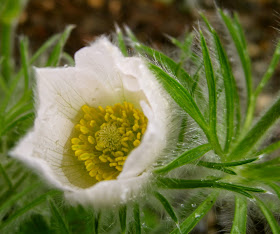Pulsatilla vulgaris is also known as Pasqueflower, a reference to Easter, which basically just means it blooms in early spring. One of the features of this plant that I find so endearing is that it is fuzzy all over, with tiny hairs on flowers and foliage that often catch raindrops and glisten. But unlike the also-fuzzy lamb's ear, Pasqueflower doesn't become a smelly, bedraggled, soggy mess in our very wet PNW climate.
The Royal Horticultural Society has given the plant its Award of Merit (Read about it at the RHS website here, where you'll also find a delightful list of other common names). In England it is considered Vulnerable and is classified as a Priority Species in the UK Biodiversity Action Plan. In its natural habitat, it grows in wooded areas or meadows, often in calcium-rich soil. There is a large colony (estimated at over 20,000 plants) in the Cotswolds, at the Gloucestershire Wildlife Trust's Pasqueflower Reserve.
 |
| White Pulsatilla vulgaris in the gravel garden |
 |
| White Pulsatilla growing with companions black mondo grass, Ann Folkard Geranium, Sedum 'Angelina' and Kniphofia caulescens |
Pulsatilla vulgaris is hardy from Zone 4 to 8 and likes well-drained soil in full sun to part shade. The flowers open when the stems are only about 4 to 5 inches tall, and after flowering, as the fluffy seedheads reminiscent of a Clematis form, the stems elongate further. I always leave the decorative seedheads for a long time, but have never seen them self sow. Once established, they set down long taproots and resent transplanting. Several different online resources claim that slugs and snails may eat new growth, but I've never had a problem with that, perhaps because I have other food to keep the buggers entertained.
 |
| Red Pulsatilla nearby getting ready to flower |
I bought mine online from Bluestone Perennials here. It's also available from other online nurseries.
ForestFarm
Shooting Star Nursery
You can also buy seeds here from Chilterns.
 |
| A closeup of the white Pasqueflower showing the delicately hairy nature of the entire plant |
What wildflowers do you grow?
Wildflower Wednesday, a celebration of wildflowers from all over the world, is hosted by Gail at the blog clay and limestone, and appears on the fourth Wednesday of each month. You can read about Gail's current featured wildflower False Rue Anemone here. Check out what other bloggers are saying about the wildflowers they grow.
